Details of the service of my distant relative are shown here as a tribute to him and the sacrifice he made during the Great War.
I hope that the report below helps to illustrate the type of research report that can be produced for a serviceman of the First World War. No service records exist for Victor, the content below has been pulled together from the other documentation that still exists. Surviving documentation can vary widely from one serviceman to another and until research begins it is not possible to state with any accuracy how detailed any final report might be.
Victor was born in 1897; he was the ninth of the thirteen children of Charles George Waymark and Elizabeth Frances Waymark (née Tapsell). His siblings were: George Charles (born 1882), Winifred Rosella (born 1883, died 1884), James Tom (born 1884), Charles (born 1887), Emmanuel Joseph (born 1889, died 1890), Edwin Joe (born 1891), Emmanuel John (born 1893), Ernest Victor (born and died 1896), Archibald Ernest (born 1900, died 1901), Frances Jane (born 1901, died 1904), Rosella May (born 1903) and Frederick Sidney (born and died 1906).
Charles George Waymark and Elizabeth Frances Tapsell were married in 1881 in Lambeth. The oldest six children of this family were born in Eastbourne, Sussex and the younger children were all born in East London.
Victor’s father, Charles George Waymark, was born in Eastbourne in 1853 and worked as a fisherman in his younger adult life. After moving to London, Charles worked as a labourer, including at the docks and by 1906 he was working as a diver. Charles died in West Ham in 1907. Victor’s mother, Elizabeth Frances, was also born in Eastbourne. She worked as a laundress after the death of her husband and she died in Poplar in 1940.
Victor’s birth was registered in the district of Stepney 1897 and he was baptised at St. Paul, Shadwell on 11th July of the same year.

By the time the 1901 census was taken, Victor and his family were living at 21 Sewell Street, in West Ham. His father was working as a dock labourer and elder brother James was a messenger in a shop.
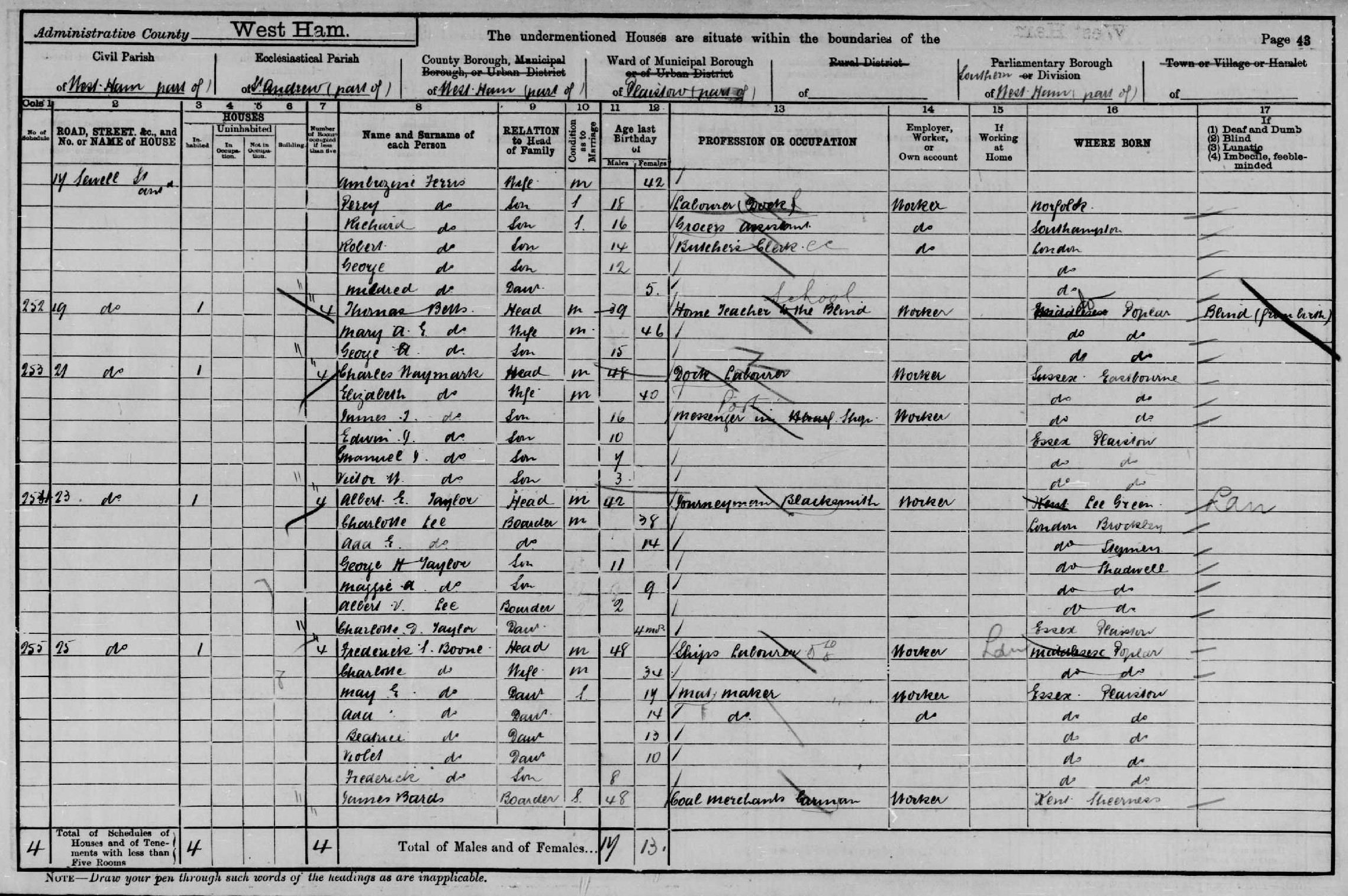
On 24th January 1907, Victor’s father committed suicide. This must have put enormous strain on the household and by 1911 Victor’s mother was lodging in Wandsworth and working as a laundress; the rest of the family had been broken up with all surviving children living separately.
From the 1911 census onwards, all records refer to Victor William as ‘William Victor’ and these notes will use his chosen name of William from this point. At the time of the 1911 census William was an inmate house boy at the House Boy Brigade institution on Marylebone Road, although his place of birth was incorrectly recorded as Eastbourne. The House Boys Brigade took in impoverished boys and trained them for duties as servants.
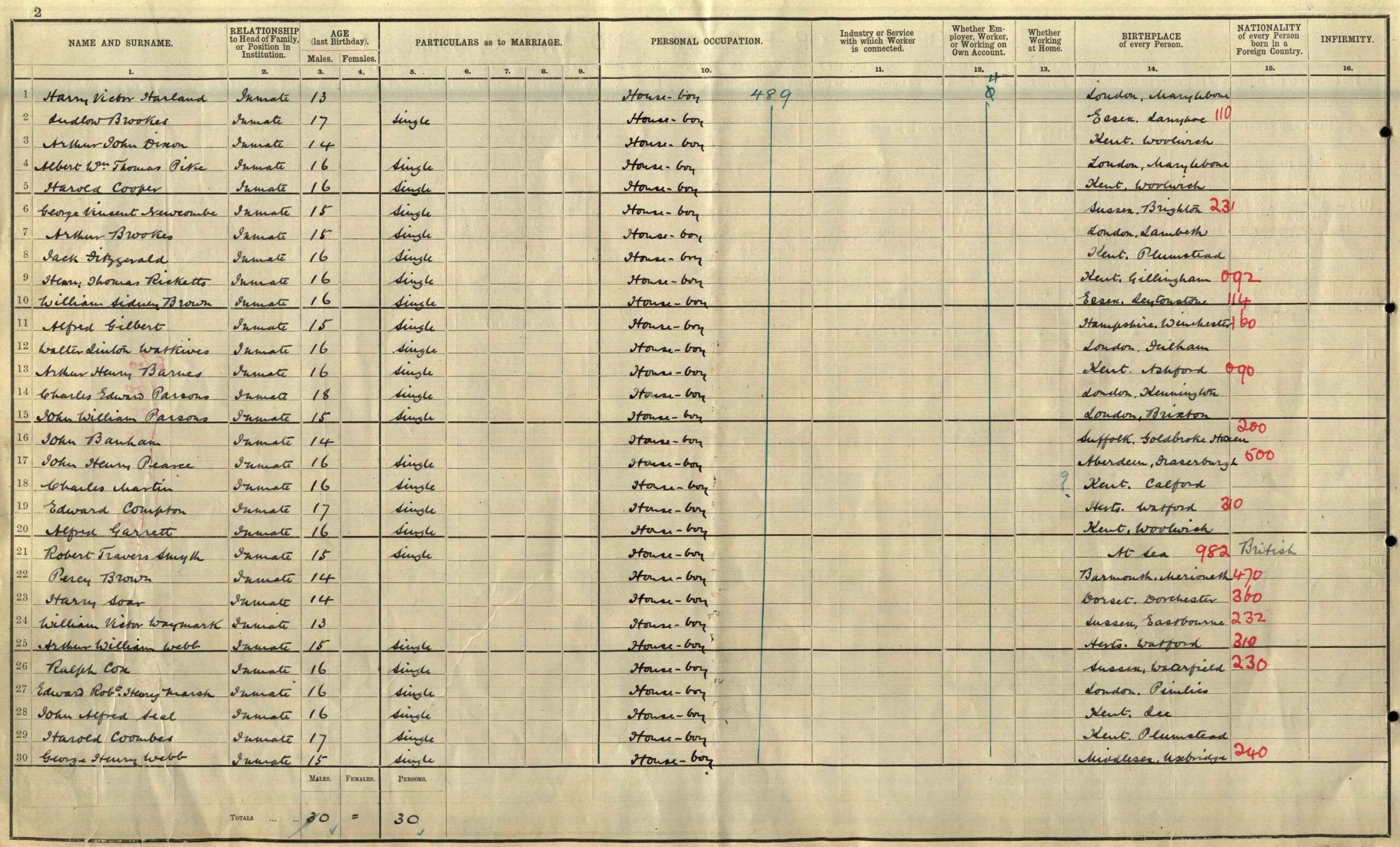
After the outbreak of war, during William enlisted with the Rifle Brigade (The Prince Consort's Own), apparently in Swindon. Perhaps he had been placed with a household there by the House Boys’ Brigade? William served with 7th Battalion in A Company as Rifleman 6173. Unfortunately, William’s service records have not survived and so his army career has been pieced together from remaining documents, including the War Diary of 7th Battalion.
The Battalion had arrived in Boulogne in May 1915 and served as part of 14th (Light Division); William joined the Battalion in Poperinghe around 18th September 1915. The Battalion War Diary shows that 7th Battalion was based in and around Ypres and Poperinghe, holding their trenches in the Saint Jean Sector at Ypres until the third week of February 1916 when they were marched to the neighbourhood of Cassel where they were entrained for a journey to Amiens via Boulogne.
They detrained at Longeau, two companies were bussed and two companies were marched to Naours, just north of Amiens, arriving on 22nd February. Plans for the Battalion to be deployed on the Somme were changed, however, and on 24th they departed Naours, marching via Doullens and Warluzel to Arras, where they arrived on 28th February.
The Battalion stayed in and around Arras, initially holding the Ronville sector, to the east of the town. Billets at Arras were in habitable houses. Trenches in the Ronville Sector were described in the War Diary as being “a paradise of comfort in comparison with Ypres.”
In May 1916 the enemy around Arras were more active than they had been through March and April. The Battalion were attached to XVII Corps forming working parties, mining and carrying. On May 21st the Battalion became involved in an attack launched by the Germans after heavy bombardment and a discharge of gas. Part of the British line was captured, but a counter-attack, in which the Battalion took part, saw it recaptured.
At the beginning of August 1916 the Battalion were marched to Gouzaincourt near Doullens where they had a week’s training before being marched to Albert before moving on to Delville Wood and Montauban where they were in reserve. On 18th August 14th Division attacked from Delville Wood to the slopes north of Longueval. The 7th Battalion attacked Orchard Trench and Wood Lane with 7th Battalion of King’s Royal Rifle Corps (60th Regiment of Foot); “A” Company of 7th Battalion R.B. held Orchard Trench until the night of 19th/ 20th August when they were relieved.
At the end of August the Battalion returned to Warlus, near Amiens, the War Diary states that they were resting.
On 15th September the Battalion were deployed in at attack at Delville Wood. The objective was to capture Gap Trench and then push on beyond the Gird trench system and to take the village of Gueudecourt, a distance of about 3 miles. At one point during the attack, the 7th Battalion outran the rolling barrage which led to some casualties before the Battalion halted. The Battalion held about five hundred yards of Gap Trench but had lost a significant number of men in the attack; they were relieved on 16th September.
Movements during the autumn of 1916 were frequent with the Battalion being moved back to Albert, then to Arras where they spent some time in the line at Wailly. On October 25th the Battalion came out of the line and marched to Sombrin via Beaumetz. During November 1916, 7th Battalion was based in Sombrin, training in billets. During December they moved back to Arras, going into support at Rivière.
The first few months of 1917 were spent to the south east of Arras, and then in and around Sombrin, Simencourt, Dainville. In February the Battalion was used to form large working parties, employed in the construction of a new railway. Much of March was also spent in working parties in and about Arras with little training possible.
On 1st April, the Battalion was moved into the Ronville Caves under Arras. The war diary notes:
"The caves are chalk excavations of considerable antiquity, covering a large area under the suburbs & city of ARRAS. The depth varies from 70 to 90 feet – various exits have been cut for military requirements – they are lit by electricity throughout. Although damp & heavy atmosphere – there was a complete absence of noise from the guns – the men were fairly comfortable & got good rest."
The Battalion took part in the Battle of Arras at the beginning of April 1917. The artillery barrage failed and enemy wire was almost entirely uncut but the chief obstacle was machine-gun fire enfilading the Brown Line, which was the intended target of 7th Battalion. The Battalion was relieved on the night of 11th/ 12th April and went into Reserve at Sombrin.
Towards the end of April they were marched to Wancourt, to the south-east of Arras, where they returned to the line south of the River Cojeul between Wancourt and Vis-en-Artois. On May 3rd, the 14th Division attacked at Chérisy, the 7th Battalion were in support but were subjected to intensive bombardment through-out the day. The Battalion stayed in this area, moving in and out of the line until the end of May.
William and Rifleman Abraham Rosen, a colleague from ‘A’ Company, were both awarded Military Medals on 26th May 1917. Sadly, the War Diary does not explain why these medals were awarded, the citations appear to have been lost by both families. William and Abraham were ‘gazetted’ on 18th June.

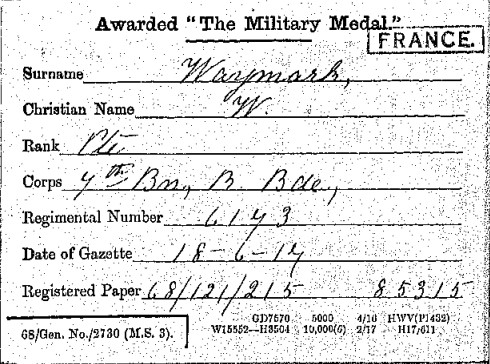
June was a quiet month for the Battalion and saw them being given a whole month for training and recreation. The Battalion moved between Beaurains and Neuville-Vitasse, to the south-east of Arras before heading out to Monchiet and then down to Bertrancourt, to the west of Bapaume. At the end of June they were inspected by H.R.H. The Colonel in Chief, unfortunately in the pouring rain.
In July the Battalion moved, probably to Beauval before being marched to Doullens where they entrained and travelled to Godeswaersveld and Clare Camp, near Poperinghe. Here, most troops trained, although one company worked on defences at Kemmel.
At the beginning of August the Battalion were marched from Frontier Camp, near Poperinghe, to Hazewinde, to the north-east of Poperinghe, where they took over farmhouse billets. In the middle of August they moved to Dickebusch before moving into the front line at Stirling Castle, near to Sanctuary Wood, south of Hooghe. They were engaged in linking a number of shell-hole posts to create a sketchy trench system and also pushing forward into further shell-hole posts. They were often under heavy barrage.
William was wounded on 26th August during actions that took place on the front line at Stirling Castle. The following is a transcription of the relevant pages of the Battalion War Diary from 24th to 26th August:
The Battalion was again moved at very short notice to an area just east of the MENIN GATE, the move being carried out in buses. The position appeared to be very precarious in the front line owing to enemy counter-attacks & at one moment it appeared that the Battalion might be called upon to counter-attack the CLAPHAM JUNCTION – STIRLING CASTLE RIDGE across the open. Eventually at about 6pm the Battalion proceeded to carry out a relief of the remnants of 42nd & 43rd Brigades then holding the line.
The same sector as on the previous tour was taken over, D Company taking the front line on the right, C Company the front line on the left, B Company being in support to C Company & A Company in support in a new trench just east of the STIRLING CASTLE WOOD. A Company of the 8th Yorks & Lancs Regt. was placed at the disposal of this Battalion on 25th inst. & took up a position in JAM SUPPORT TRENCH with 2 platoons in immediate Reserve at OBSERVATORY POST.
The position throughout was a very anxious one; the area was continually shelled for long periods, the position had to be consolidated in view of expected enemy counter-attacks while two actual operations had to be carried out.
On 25th inst. Orders were received for the operations. The operation was carried out by C Company & in the course of it 2/Lt W HOSLER was last seen endeavouring to repel the enemy counter-attack which immediately developed on the post occupied at J14c.65.55. He was, it is feared, killed.
On 26th inst. orders were received for operations to be carried out in the morning of 27th August. The weather turned very wet on the evening of 26th inst & the platoon of A Company which carried out the attack was enormously hampered by the bad conditions of the ground in addition to the essential fact that the tanks could not get forward owing to the mud. 2/Lt RUSHBROOKE in charge of this attack was, it is feared, killed.
Immediately before the relieving Battalion (the 8th Yorks & Lancs) arrived the enemy developed a heavy counter-attack. The credit of the successful repulse of this heavy attack belongs to C Company under Capt. W J SHAW & to the platoons of B Company which were under Capt. SHAW at that time. The Casualties during this tour were 5 Officers & 131 O.R.
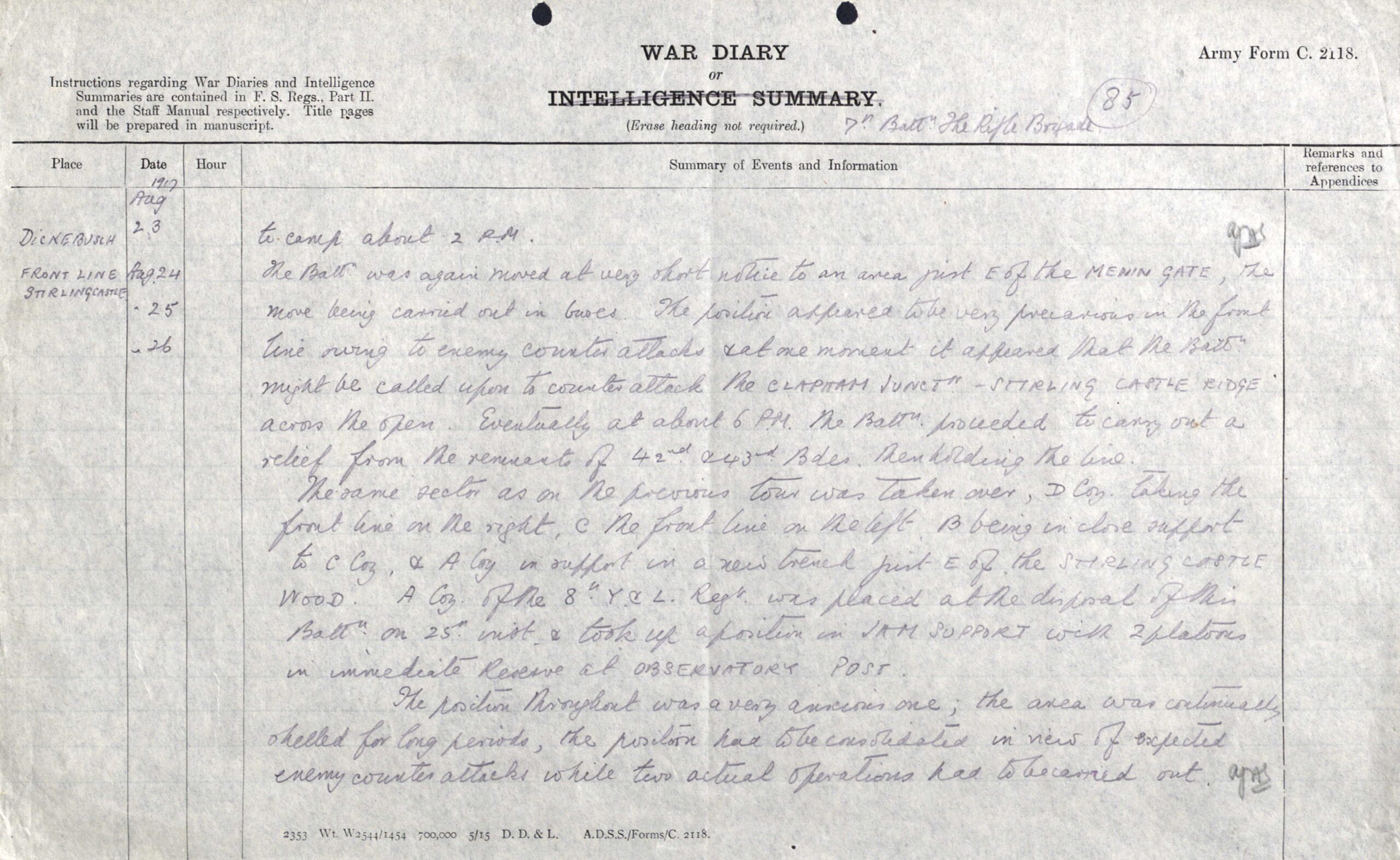
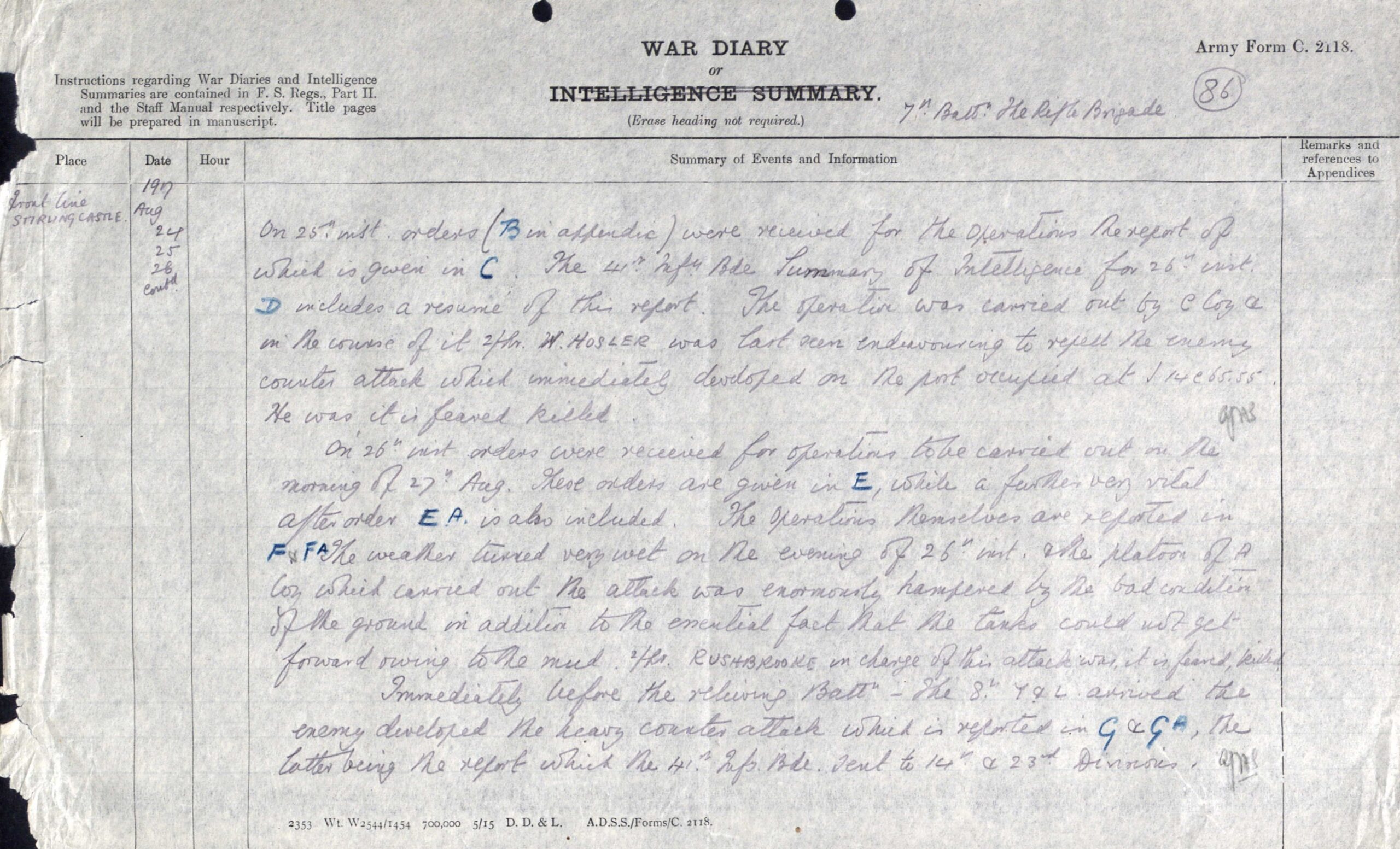
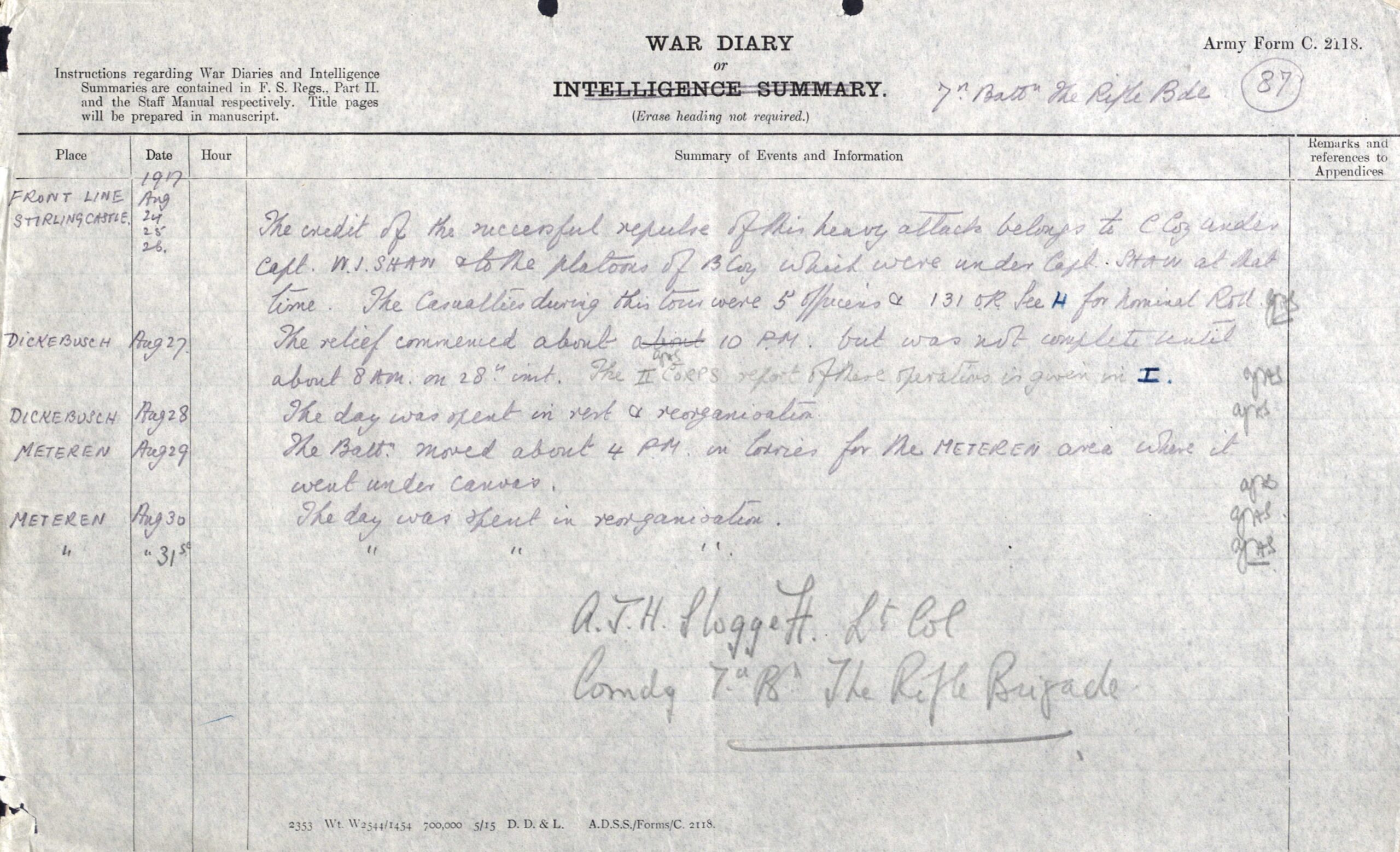
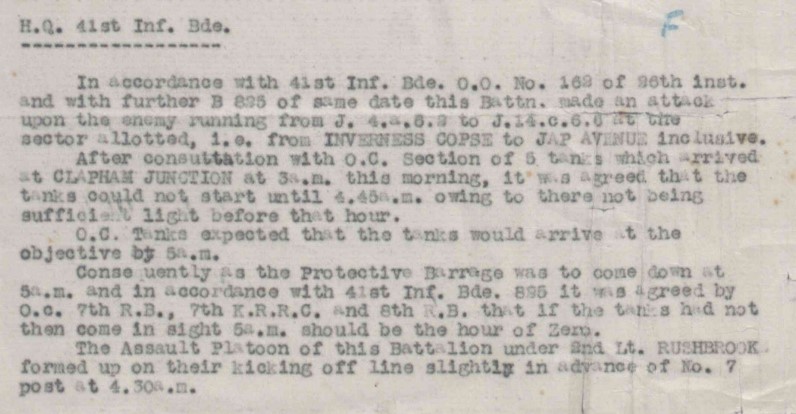

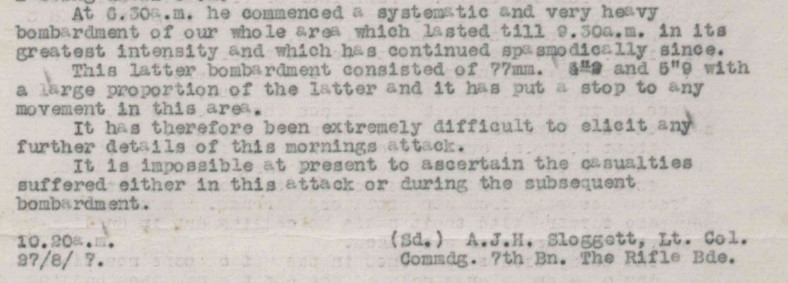
On 27th August William was taken to No. 10 Casualty Clearing Station which was based at Remy Siding near Lijssenthoek. He died of his wounds later that day and was buried at Lijssenthoek Military Cemetery in plot 18.G.12A.

The headstone of
6173 Rifleman
William Victor Waymark, MM
Buried at Lijssenthoek Military Cemetery
Photograph taken in April 2019
In the event of my death I give the whole of my property and effects to my sister Miss Rose Waymark c/o Mrs J Howell, 78 Latimer Road, Eastbourne, Sussex.
Signed William Waymark
Rifleman No. 6173
7th Batt. Rifle Brigade
My Medal I leave to Mrs J Howell, 78 Latimer Road, Eastbourne
Date 21st April 1917
The bequest of the medal to William’s Aunt Jane (known as Jinnie) looks to be a later addition.


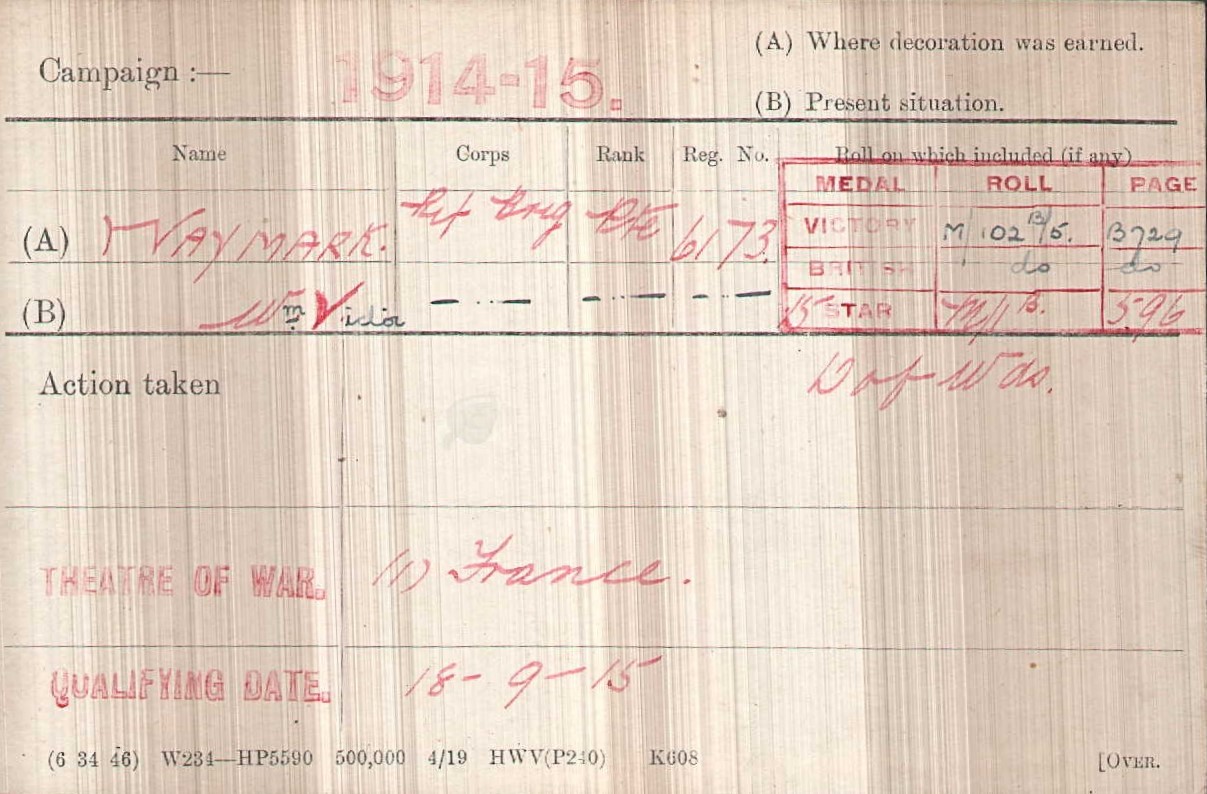
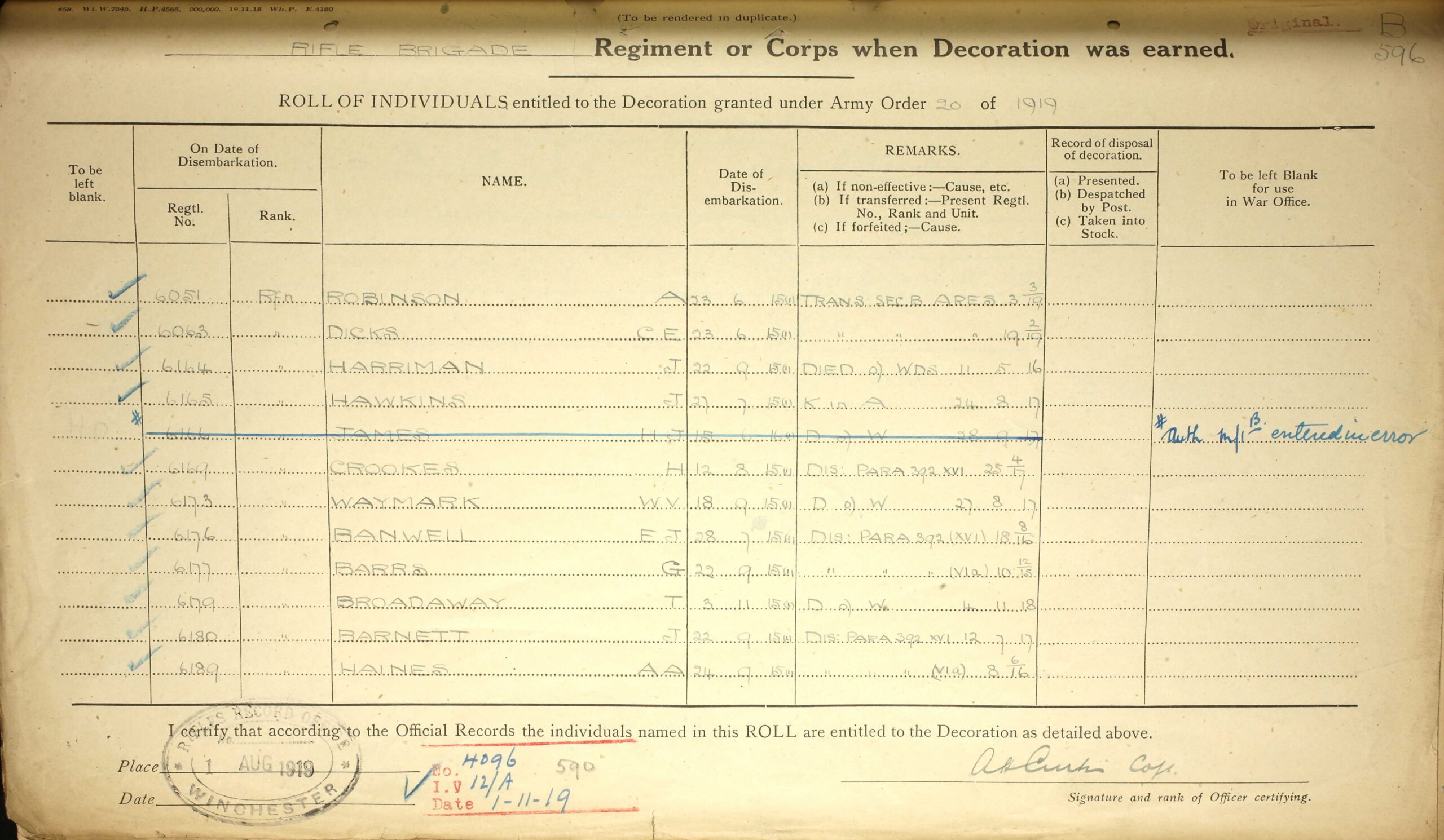
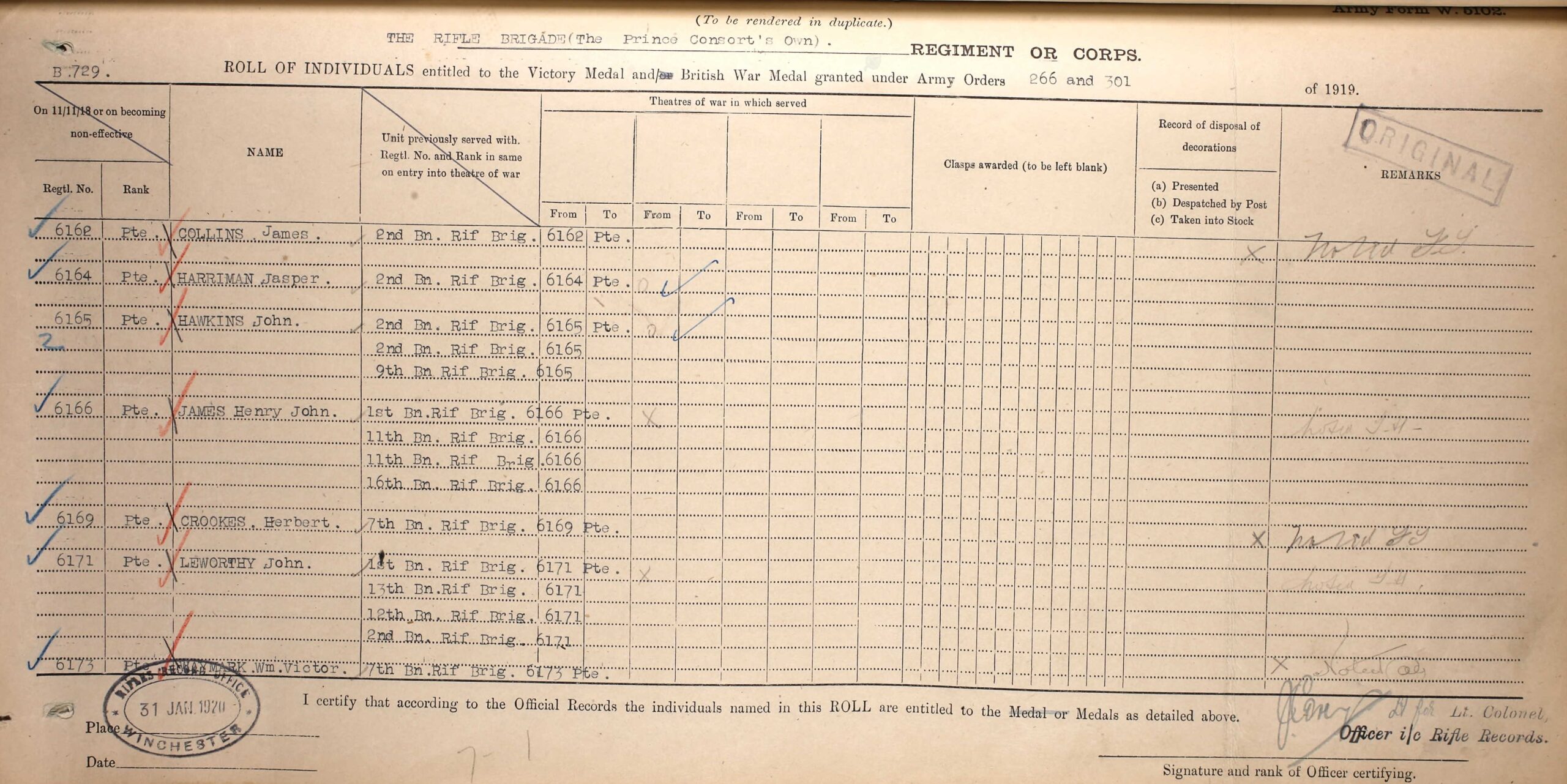
Payments were made to William’s sister Rosella in December 1918 (£4 7s 6d) and February 1919 (£13). In June 1919, form AFW 5070 was sent to William’s next of kin requesting and address where his effects could be sent. It seems that Rosella was living with her Aunt Jinne (Mrs J Howell) during the First World War, she was only fourteen at the time of William’s death so it may be that Aunt Jinnie acted as her guardian. Sadly, Rosella died in 1921 when she was only seventeen.
After the war William was posthumously awarded the 1914-15 Star (August 1919); in January 1920 he was awarded the British War Medal and the Victory Medal.
Additional Sources Used
Soldiers Died in the Great War, 1914-1919 (HMSO, 1921)
Long Long Trail (Chris Baker’s website)
The History of the Rifle Brigade in the War of 1914-1918, Vol. 1 & Vol. 2 (Reginald Berkeley)
Battalion War Diary
